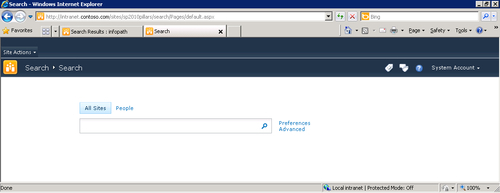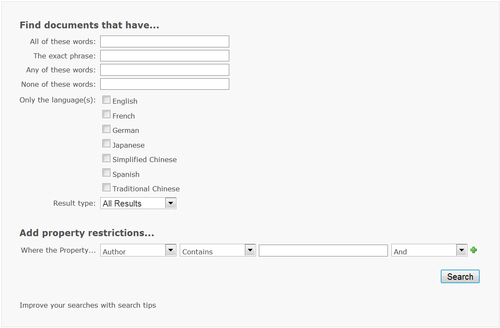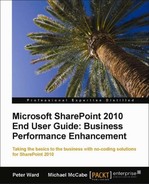You can search in SharePoint using the search box (on the right in the following screenshot) to enter your keyword or search term. The search box appears on most sites and pages in SharePoint out of the box.
Note
If you create custom pages, you can add the search box web part to them. Chapter 13, Pages and Web Parts discusses how to add web parts to a page on a SharePoint site.

The search center is another option. The search center is a site in itself and can be accessed from a tab on a parent site (on the left of the preceding screenshot).
The search center interface is simple and clean with just a search box on the page. The search center is useful as a central place, usually at the top level of a SharePoint portal hierarchy, where users can search content stored across sites rather than just the content on an individual team site, for example.
You can select a specific scope to focus your search. In the following example, the default scopes All Sites and People are shown:

Note
Scopes define specific sites or data repositories for your search. All Sites and People are default scopes in SharePoint. Administrators can define custom scopes. For example, a scope could be defined for the legal department that only shows results from a site where contracts are stored. By selecting that scope, they reduce the search results to those documents they work with most often.
With SharePoint 2010 you can enter complex criteria for searches that were not possible in SharePoint 2007. You can use combinations with connectors such as AND, OR, or NOT. For example, you could do a search using (Finance AND Legal), or (SharePoint Search OR Windows Search).
But, an easier way to enter multiple criteria for your search is to use the advanced search interface. On the search center page (as shown previously) next to the search box, click the Advanced link and you will see the advanced search interface as shown in the following screenshot:

The advanced search form allows to you search for multiple terms, exact phrases, or exclude terms. You can specify languages or the type of result you are looking for, such as Word, Excel, or PowerPoint files. You can even restrict your results to criteria based on properties of the results, such as author or modified date. By clicking the + sign after the first Property, you add more fields and criteria.
Entering your criteria is the most convenient way to combine multiple criteria. You can visualize them in the form, and avoid errors when typing them as one long string.
The * character can be used as a wildcard at the end of a string you use in your search criterion.
Note
The wildcard character can only be used at the end of a string; therefore, in SharePoint terms its use is referred to as prefix matching instead of wildcard.
Entering com* could return company, communications, or computer, for example.
SharePoint 2010 search will return phonetic matches and nicknames when you search for a name. For example, searching for John will return Jon, or Jean. Searching for Jeffrey will return Geoffrey, but also Jeff and Geoff.
This can be especially useful in a global company, where employee names are often long and difficult to remember.
